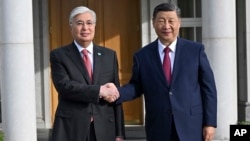Welcome back to the China In Eurasia briefing, an RFE/RL newsletter tracking China's resurgent influence from Eastern Europe to Central Asia.
I'm RFE/RL correspondent Reid Standish and here's what I'm following right now.
A Blueprint For Eurasia
Chinese leader Xi Jinping, Russian President Vladimir Putin, and other leaders who are members of the Shanghai Cooperation Organization (SCO) will kick off a two-day summit in Kazakhstan starting on July 3 as the bloc is poised to grow again.
But where does this club of mostly illiberal states fit into Beijing and Moscow’s wider plans?
Finding Perspective: The SCO is helmed by China and Russia, but also includes India, Iran, Kazakhstan, Kyrgyzstan, Pakistan, Uzbekistan, and Tajikistan as members. This year’s summit is headlined by the admission of Belarus into the organization.
This marks a trajectory of growth for the SCO over its 23-year history. Since it was founded in 2001, the bloc has shifted from a forum mostly focused on Central Asia into a Eurasia-wide organization with ever-growing ambitions.
In its early days, this was centered on China settling its borders with its western neighbors following the collapse of the Soviet Union and looking to expand its influence, while assuaging any anxieties in Moscow. Over time, things have shifted to counterterrorism, economic development, and regional security.
But it’s also increasingly becoming a venue for Beijing to show its growing heft around the region, a development that is continuing as Xi arrived early in the Kazakh capital, Astana, for a state visit and then will do the same in Tajikistan after the summit.
The bloc has also begun to feature more prominently in shared statements from China and Russia, with the SCO getting notable shout-outs during Xi and Putin’s “no-limits” partnership summit in February 2022 and other meetings between both leaders as they look to cooperate more through the organization.
Beijing And Moscow: China and Russia’s shifting dynamic has been a boost for the SCO.
After years of Russia using the bloc to water down Chinese influence in the region – and blocking Chinese-initiatives like an SCO development bank and free-trade zone – the Kremlin shifted to working more closely with China.
This began during Russia's isolation from the West that took hold in 2014 and has only grown since the full-scale invasion of Ukraine. Moscow has also started to accept that it has fewer cards to freeze out China and that the SCO can serve as a valuable forum to build support and undermine Western claims that the war in Ukraine has turned it into an international pariah.
Why It Matters: As the SCO has grown, its true value rests in symbolism rather than in any practical policy.
On paper, it’s one of the world’s largest regional organizations, accounting for around one-third of global GDP, roughly 40 percent of the world’s population, and nearly two-thirds of the entire Eurasian landmass.
While China has experimented with multiple iterations of the SCO, its main role has been in offering alternatives to the U.S.-led system and being another forum for Beijing to portray itself as the leader of the Global South.
China still has lots of work ahead if it wants to transform the SCO beyond its reputation as a talk shop for authoritarians. India and Pakistan’s rivalry will always be an impediment to the organization, but recently it’s been Beijing and New Delhi’s fraught relationship that’s a factor.
Last year’s SCO summit in India became a virtual one, reportedly due to an unwillingness to welcome Xi, and at this year’s summit, Indian Prime Minister Narendra Modi is the only leader not attending in person.
Three More Stories From Eurasia
1. NATO Keeps An Eye On The Asia-Pacific
Russia’s war in Ukraine is the main issue on NATO’s mind, but when leaders from the military alliance gather in Washington on July 9-11, they’ll also be turning their attention toward China.
The Details: NATO officials told RFE/RL that the upcoming summit will have a special China session, and the military alliance is looking to include Asia-Pacific partners like Japan, South Korea, and Australia, who have all been invited at the highest level.
While NATO is a defensive alliance focused on European security, China has become more of a focus in recent years.
Outgoing NATO Secretary-General Jens Stoltenberg has warned in the past about the risks posed by Chinese state firms building critical infrastructure in Europe and said in June that Beijing should face consequences for supplying Russia’s war effort with dual-use goods.
2. Is Central Europe Back On The Menu?
After years of setbacks that saw all three Baltic countries withdraw from China’s forum to engage with Central and Eastern Europe and others downgrade it, Beijing is on a charm offensive that could swing the pendulum in the other direction.
What It Means: Polish President Andrzej Duda recently wrapped up a visit to China, where he praised ties with Beijing and was lauded by Chinese media for his “warm attitude.”
Hungary is and remains a key partner for China in the region and recently took over the rotating presidency of the EU Council for the rest of 2024 amid tense trade spats between Beijing and Brussels.
In Slovakia, the country’s populist, Euroskeptic government is also apparently flirting with stepping up engagement in the 14+1, the Chinese forum that was previously the 17+1 before Estonia, Latvia, and Lithuania pulled out.
Matej Simalcik, executive director of the Central European Institute of Asian Studies, said that Jiang Yu, China’s special envoy for the 14+1, recently held meetings with Slovak officials in Beijing. Slovak Prime Minister Robert Fico is also slated to visit China this fall.
Now, Duda is nearing the end of his term and Poland elected Donald Tusk, whose stance on China is more critical, as prime minister in December. Duda also used part of his visit to attempt to foster division between Beijing and Moscow during a speech to Chinese university students by bringing up how territories along their shared border were lost to Russia during tsarist times.
The Czech Republic continues to have a government and president that hasn’t been shy to criticize Beijing, but a change of government in the near future isn’t out of the question.
With populist former Prime Minister Andrej Babis polling strongly, the Czechs could also start to walk back some of their tougher positions if the ruling coalition doesn’t survive the next vote.
3. A Megaproject Comeback
While China has been the main source of foreign direct investment in Central Asia in recent years, Beijing took a step back when it came to building sprawling infrastructure projects.
But with a much-discussed railway between China, Kyrgyzstan, and Uzbekistan getting the green light, that may be about to change.
What You Need To Know: My Almaty-based colleague Chris Rickleton looked at Kyrgyzstan and Tajikistan, Central Asia’s two poorest countries, and recent projects and large deals signed with Chinese companies and lenders.
The China-Kyrgyzstan-Uzbekistan railway agreement is significant in that it offers some revealing details about the divisions of financial responsibility.
According to the agreement, the trio will form a joint company in which China will hold a 51 percent stake while Uzbekistan and Kyrgyzstan will be responsible for 24.5 percent each.
But the issue of its funding is still somewhat unclear. Kyrgyz official estimates for the cost of the railway vary from $4.5 billion to $8 billion. That will likely require large loans from a major Chinese state bank. The agreement proposes using a structure where Kyrgyzstan could limit its debt exposure by granting full control of its portion to a Chinese firm and forfeiting part of the revenue the railway generates from transit fees until building costs are repaid.
In Tajikistan, Chinese investors pledged $500 million in new deals at an expo in June, as well as a $1.5 billion commitment from a Chinese company to build a solar power plant near Tajikistan’s border with Afghanistan.
The deals could be crucial for Tajikistan’s investment-starved economy, but the country is already highly indebted to China and has few avenues to pay it down.
Across The Supercontinent
The EV Expansion: The first batch of plug-in hybrids rolled off the assembly line at a new plant from China’s BYD in Uzbekistan. The Central Asian country is aiming to position itself as the main hub for Chinese electric vehicles (EVs) as the automaker eyes the region for expansion.
Modi To Moscow: Worried by Russia’s deepening ties with China, Indian Prime Minister Narendra Modi will head to Moscow for talks with President Vladimir Putin, Bloomberg reports.
Rare Earth Edict: China’s State Council issued a raft of regulations to tighten management of rare earth minerals, which are playing an increasingly strategic role in the global technology race.
Indirect Trade: While much of China’s support for Russia amid its war in Ukraine occurs bilaterally, an increasing percentage is diverted through Central Asia and other locations. The Atlantic Council’s Joseph Webster breaks it down here.
One Thing To Watch
Nicholas Burns, Washington’s ambassador in Beijing, gave an interview to The Wall Street Journal where he rebuked Chinese authorities for undermining attempts to repair ties with the United States, interrogating and intimidating Chinese citizens who attend U.S.-organized events in China, and whipping up anti-American sentiment.
The comments reflect unusually forceful language from Burns and show ongoing frustration over a lack of progress on any attempts at improving relations between Beijing and Washington.
That’s all from me for now. Don’t forget to send me any questions, comments, or tips that you might have.
Until next time,
Reid Standish
If you enjoyed this briefing and don't want to miss the next edition, subscribe here. It will be sent to your inbox every other Wednesday.









